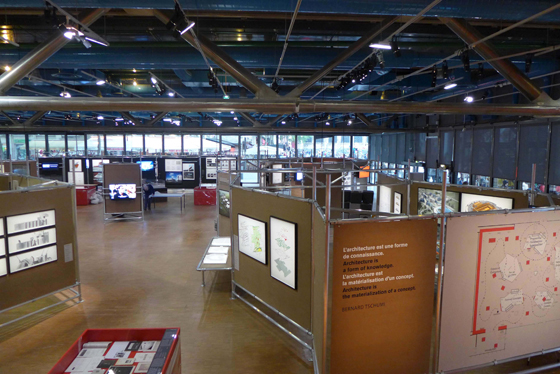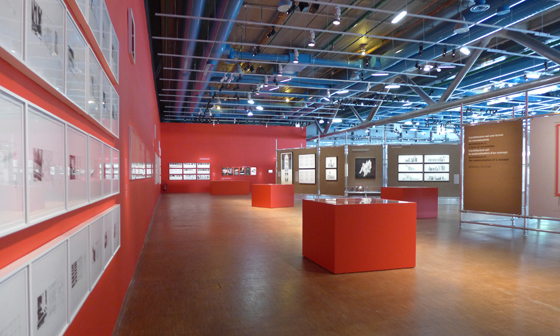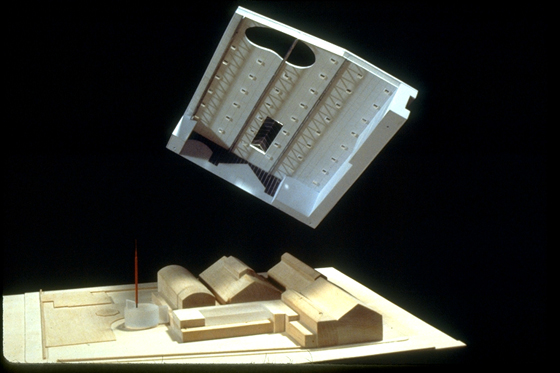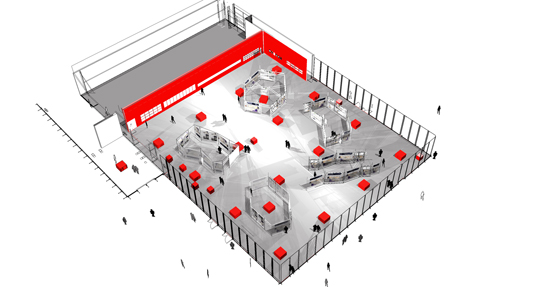Maintenant – Bernard Tschumi at the Pompidou Centre
Text by Klaus Leuschel
Bern, Switzerland
03.06.14
Among the numerous signs that one's status as a grandee of architecture has been secured is having a big survey exhibition at Paris's Pompidou Centre. Architonic uses the current Bernard Tschumi retrospective as an opportunity to reflect on the Swiss architect's innovative and diverse projects.
Completed in 2010, Bernard Tschumi's bridge in La Roche-sur-Yon, France, links the historic town with new neighbourhoods

Completed in 2010, Bernard Tschumi's bridge in La Roche-sur-Yon, France, links the historic town with new neighbourhoods
×Jean Nouvel, Richard Rogers (the architect who designed ‘Beaubourg’ – the old guard of the Left would never use its official name!) and a few others have all had one – a monographic show at the Pompidou Centre. Now it’s the turn of Bernard Tschumi, born in Lausanne in 1944, who, having completed his architectural studies at the ETH in Zurich, moved right to the heart of professional debate: although initially teaching at London’s Architectural Association, New York was ultimately his end goal. He’s been a resident of the latter city since 1976, commuting to his second office in Paris on a weekly basis.
The Bernard Tschumi retrospective at the Centre Pompidou in Paris
Architecture for giraffes and elephants
Over 350 collages, sketches, drawings and models – a lot of them shown in public for the first time – were brought together for the exhibition, which, organised over 1,000 square metres, opened on 30 April. The show also features an installation by the architect himself of archive and film material. More than 40 projects, ranging geographically from Europe and the US to China and the Middle East, are presented. Tschumi’s focus is squarely on the transformation of the idea into architectural concepts, allowing glimpses into the design process as well as into the realisation of individual building projects, such as the venue and exhibition space Zenith in Rouen (1998–2001), the Flon interchange in Lausanne, and the Parc Zoologique in the Parisien suburb of Vincennes, which opened its doors for the first time a mere two weeks before the opening of the retrospective.
Athens' Acropolis Museum (2001–09; top) and Le Flon interchange in Lausanne, Switzerland (2001; above)

Athens' Acropolis Museum (2001–09; top) and Le Flon interchange in Lausanne, Switzerland (2001; above)
×Bernard Tschumi has ranked among one of the most significant forces in contemporary discourse since the mid-1970s, not least due to his often provocative projects, which, through the way in which they invite one to experience architecture, to move through it, approach the experience of film. All of this is documented in more than two dozen tome-like publications, which allude to everything from philosophy to advertising. Central to them are the concepts ‘event’ (‘Event Cities'; MIT Press), following Tschumi’s own propagation of the notion, and perhaps the epoch-making ‘maintenant l’architecture’, which introduced philosopher Jacques Derrida (at the request of the architect) into the discourse of architecture. Maintenant is a word that is rendered banal when translated as ‘now’, communicating so little of what Derrida (and Tschumi) were about. The discussion led to such labels as ‘deconstruction’ and ‘deconstructivism’ and found its apogee in ‘Deconstructivist Architecture’ (MoMA, 1988), an exhibition instigated by Philip Johnson.
The Parc Zoologique in Vincennes, Paris, completed in 2014
Not all of Tschumi’s projects were popular from the start. His bus shelter in Groningen, Netherlands (1990), and Paris’s Parc de la Villette (1982–87) were contentious and, in his native town of Lausanne, the Flon project (1998–2001) was viewed with highly critical eyes at the outset. But his Video-Bus-Stop there acquired an almost cult-like status a long time ago, and the Flon is now popular with both young and old, while the park in the north of the City of Light has become a popular recreation ground for the surrounding residential quarters.
Bernard Tschumi's Glass Video Gallery (1990) in Groningen, Netherlands (top), and the Zenith concert hall and exhibition complex in Rouen, France (1998–2001)

Bernard Tschumi's Glass Video Gallery (1990) in Groningen, Netherlands (top), and the Zenith concert hall and exhibition complex in Rouen, France (1998–2001)
בArchitecture isn’t a question of form, but rather a form of knowledge’
Across the exhibition’s five chronologically and thematically defined sections, a spotlight is shone on Tschumi’s modus operandi, and by extension his architecture – for example via his ‘Manhattan Transcripts’ (1981), which appeared in parallel with Rem Koolhaas’s cult book ‘Delirious New York’, or his centre for contemporary art, Le Fresnoy, in Tourcoing (1991–97), outside the French town of Lille. The exhibition examines Bernard Tschumi’s work as architect, lecturer and author. It attempts a contemporary definition of the formation of architecture through arguments, ideas, influences and reactions. Accordingly, the visitor is led, like at a theme park and past countless monitors, through five installations, each of which deals with one of the key concepts:
* ‘Concept-Forms’
* ‘Program and Superposition’
* ‘Context and Content’
* ‘Vectors and Envelopes’
* ‘Space and Event’
The last of these is an installation dedicated especially to the Parc de la Villette. But all of them fit squarely with his projects: vectors mark out paths whose axes change with each project (like Flon in Lausanne or the pedestrian bridge in La-Roche-sur-Yon, 2007–2010), while envelopes delineate the packaging of different content under one roof (for example, Vacheron Constantin, Geneva, 2001–04).
Model of the Le Fresnoy Art Centre (1991–97) in Tourcoing, France
In his catalogue foreword, Beaubourg director Bernard Blistène (CNAM/CCI) comments: ‘Given that Bernard Tschumi’s name is famously and indelibly associated with the Parc de la Villette, his first major project in France, it’s surprising that the monographic exhibition at New York’s MoMA in 1994 has had, until now, no European successor. This exhibition at the Centre Pompidou thus offers the different aspects of a career that has included not only the practice of architecture but writing, teaching, the theory of architectural education, and the organization of exhibitions, events and conferences, all of which had a profound influence on architectural debate.’
Like a miniaturised reference to his Parc de la Villette, 18 small, cube-like red tables appear in the gallery. They underpin the strong narrative way of communicating the architecture. On them, the architect also places references to film and literature, among other things, which for him aid in the explanation of architecture, in making it comprehensible. Architecture is not about form, as he continually emphasises, but about a form of knowledge.
Red tables throughout the exhibition space at the Pompidou Centre (top) make reference to Tschumi's design of the Parc de la Villette (1982–1998) in Paris
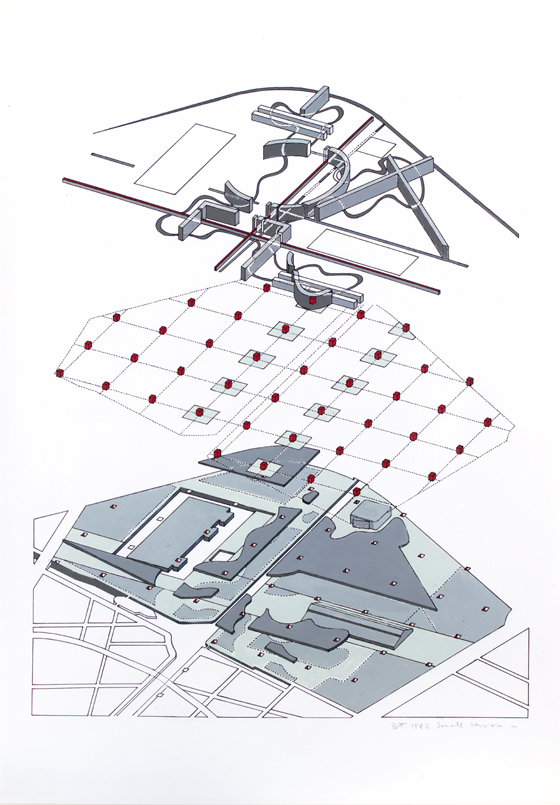
Red tables throughout the exhibition space at the Pompidou Centre (top) make reference to Tschumi's design of the Parc de la Villette (1982–1998) in Paris
×Building site, rather than churchgoing
When asked once how he arrived at his profession, Bernard Tschumi is on the record as saying, not without a degree of subtle irony: ‘What should someone, who on Sundays knocked around building sites with his old man while others were in church, become then?’ His old man meaning his father, of course – Jean Tshcumi, who, responsible for the Nestlé headquarters in Vevey and the Mutuelle Vaudoise in Lausanne, was himself a master of the profession.
…..
Bernard Tschumi Retrospective
Centre Pompidou
Galerie Sud, Level 1
30 April – 28 July 2014
www.centrepompidou.fr



